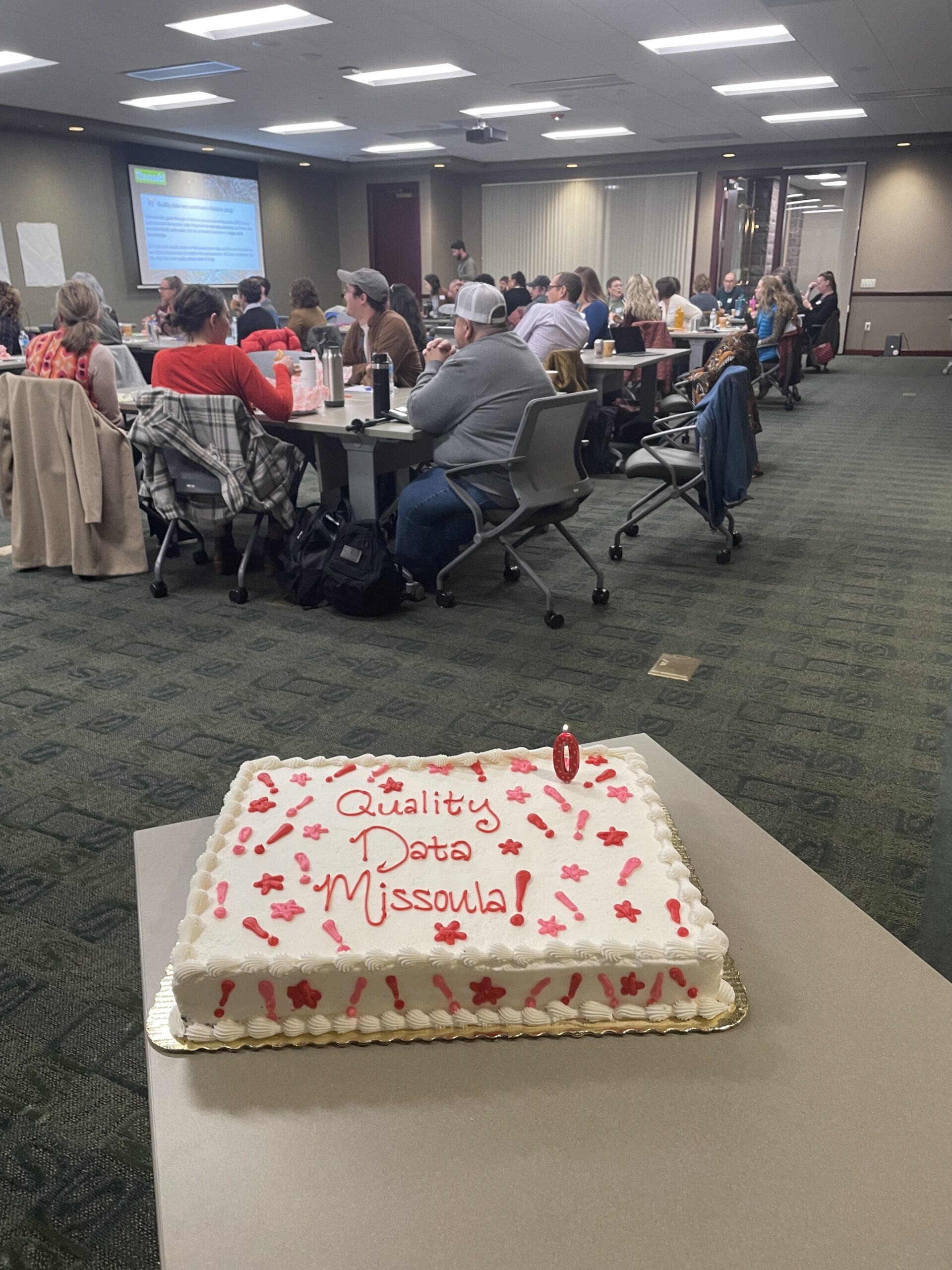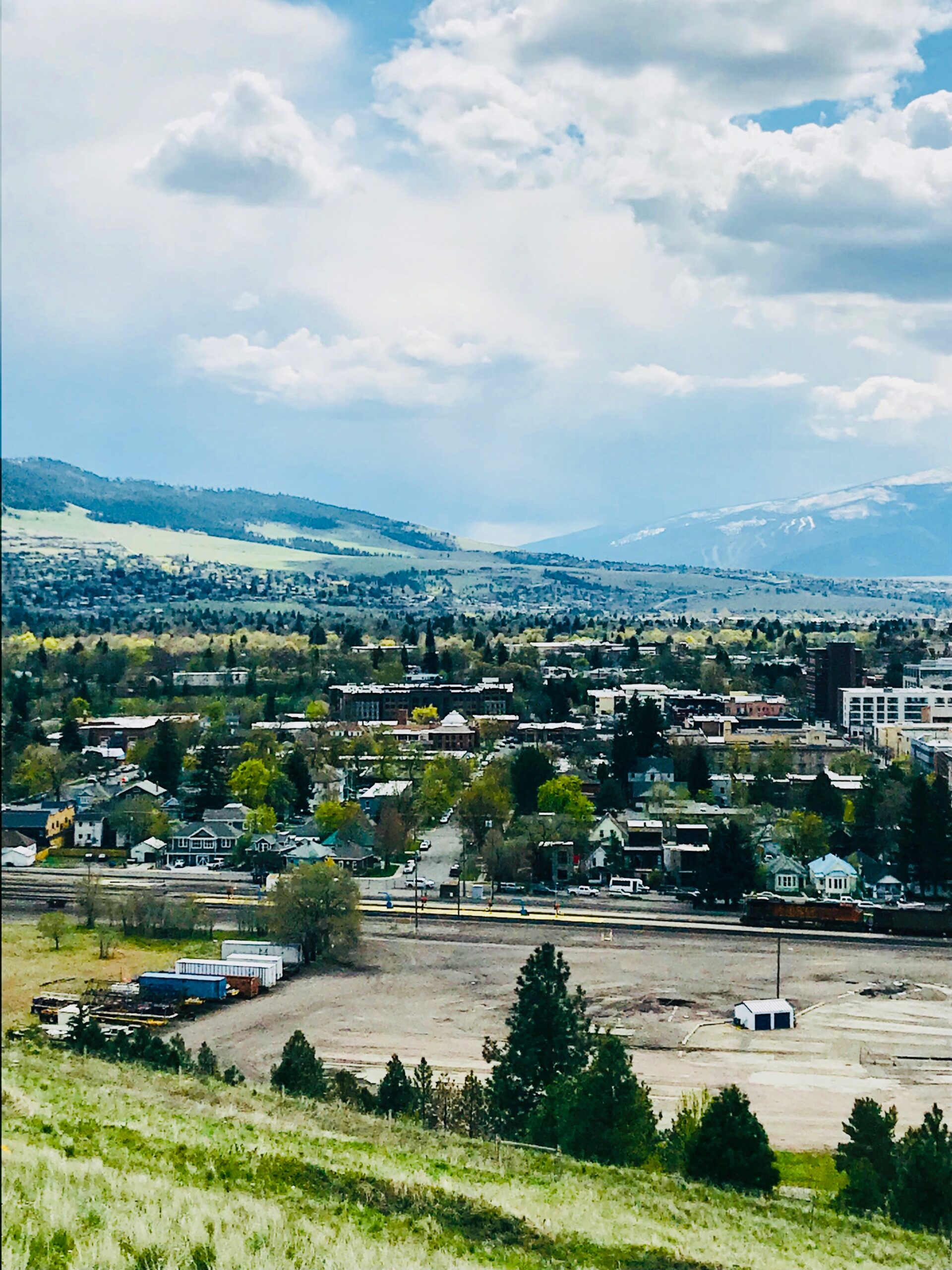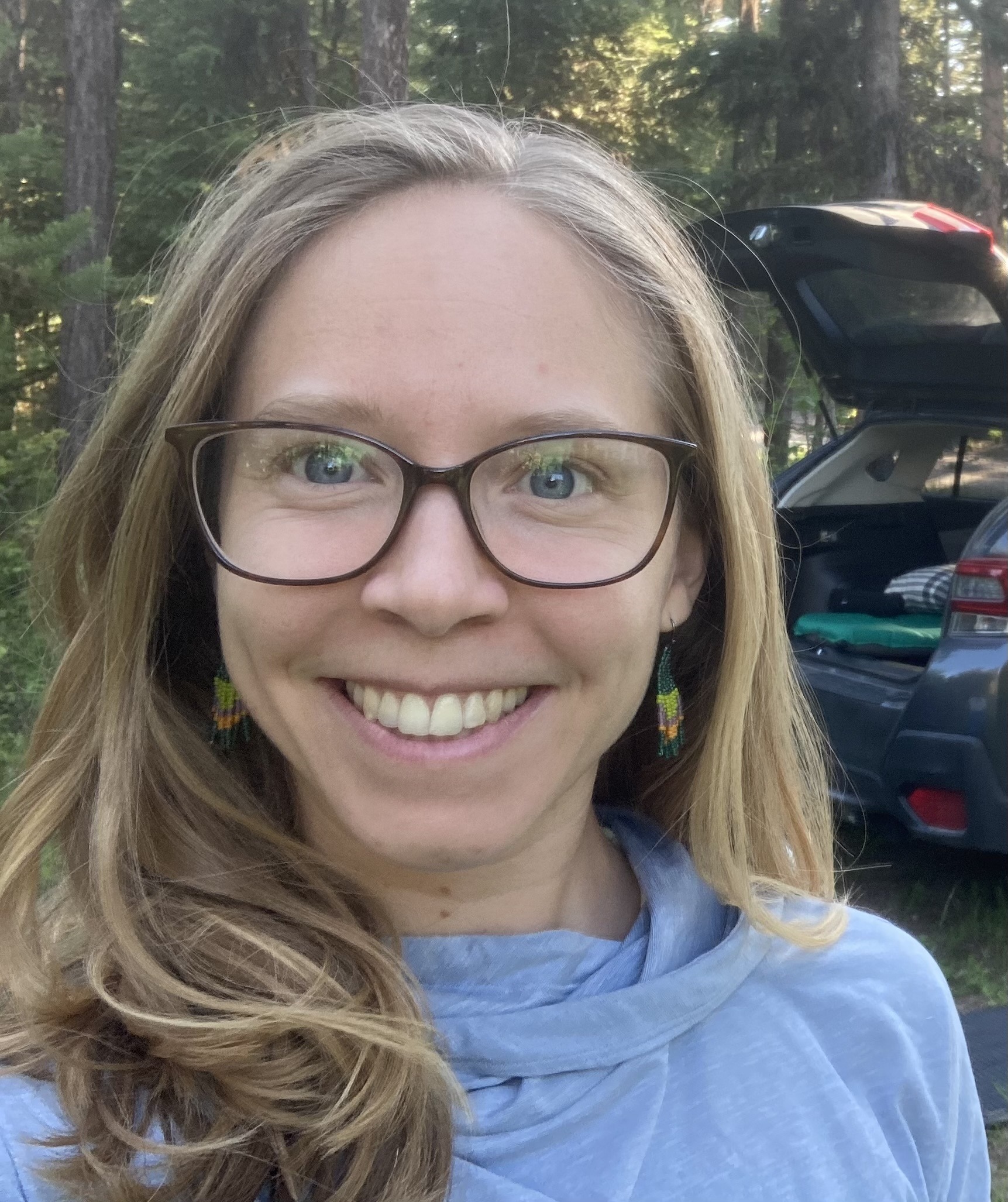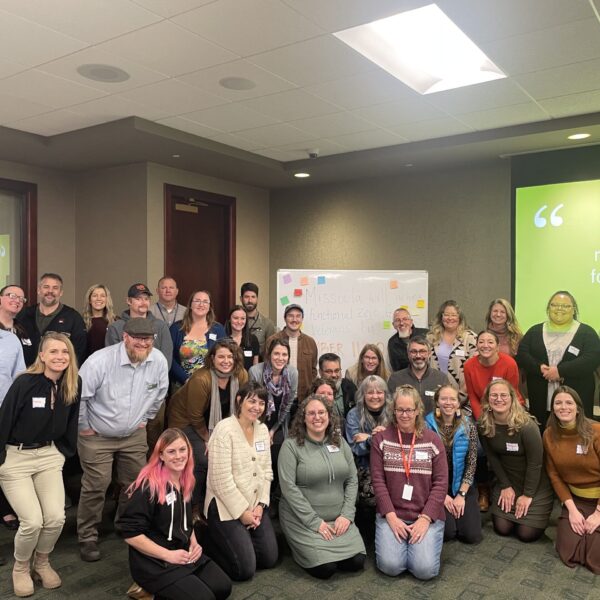“Missoula loves to come together and collaborate,” states Samantha Hilliard, Coordinated Entry Specialist for Houseless Programs at the City of Missoula.
This collective commitment and shared purpose have propelled the community to a significant accomplishment — achieving Built for Zero’s quality data milestone.
Reaching quality by-name data is more than just a statistical benchmark; it recognizes that Missoula has a comprehensive by-name data source of every person experiencing homelessness within a specific population, updated in real-time. Using information collected and shared with their consent, each person on the list has a profile that includes their name, homelessness history, health, and housing needs.
Missoula has become one of the few Built for Zero communities to reach the quality data milestone for all single adults experiencing homelessness. This broader category includes the subpopulations of veterans and people experiencing chronic homelessness, along with other single adults not part of those groups.
With this aggregate data, Missoula can see how the demographics of its homeless population change over time. For example, they can drill down to find out if their community is experiencing an increase in homelessness among older adults or whether new resources have helped decrease veteran homelessness. This big picture helps them understand trends, decide where to focus support or investments, test system improvements, and determine if their efforts are actually reducing homelessness on their way to a bigger milestone — functional zero.
Missoula’s commitment to data is more than a commitment to numbers — it’s also about being accountable to everyone experiencing homelessness and the larger community.
As Liam Seymour, Coordinated Entry Specialist at Poverello Center, Inc., said, “It’s so important for a community to be able to be confident in the information they work with, both to be able to celebrate the accomplishments and also to be able to dig into how the systems are working. Knowing that we have quality data has let us try new programs and processes, and see if that results in better serving the people we work with in Missoula!”

“It’s so important for a community to be able to be confident in the information they work with, both to be able to celebrate the accomplishments and also to be able to dig into how the systems are working.”
– Liam Seymour, Coordinated Entry Specialist at Poverello Center, Inc.
“Scrappy problem-solvers“
The City of Missoula is the lead agency for the coordinated entry system (CES), meaning they are responsible for the overall view of the homeless response system’s projects and programs. In addition, all City Houseless Programs staff work with the entire state’s Continuum of Care, influencing policy and process at that level.
But it didn’t start that way. The community first started utilizing a coordinated entry system in 2017, and they used the next couple of years to build relationships among their network of service providers. At that time, the data on their homeless populations was “very hit or miss.” However, they continued strengthening their data collection practices among the many providers across the homeless response system.
Seymour explained, “We’ve got a ton of great providers and staff getting people housed all the time, but some of the systems weren’t set up to track those changes, and so we weren’t always giving ourselves credit for the great work being done.”

In 2022, the community decided to join the Built for Zero movement and began efforts to achieve the quality data milestone.
“We were really fortunate to have a strong foundation, and I think Built for Zero just rocketed us towards where we were always meant to be going,” Hilliard said.
In pursuit of that goal, the community knew they had to understand the full scope of the problem. You can’t solve a problem you can’t see, and data is a powerful tool for identifying and implementing effective solutions as well as charting and communicating progress toward ending homelessness.
“It’s just very important to show what the need actually is,” said Sophia Shrom, Homeless Outreach Team Member and Community Outreach Team Lead at Poverello Center, Inc. “When we’re looking at how to help people, we need to know what it actually looks like so it needs to be accurate if we want to provide the support.”
This data-driven approach allows leaders at the City of Missoula to be even better stewards of their funding and begin applying strategies that are as dynamic as the problem.
“We are, as I’m sure many communities are, a bunch of really hearty, scrappy problem-solvers, but we’re working with really limited resources,” noted Emily Armstrong, Houseless Programs Manager at the City of Missoula.
“Having the data that we can trust to tell us who needs the resources and what kind so that we can target those resources and funding specifically benefits the whole community. It eliminates some of that guessing and makes it so that we can create actual solutions that we’ve been told are the solutions folks need.”
Full participation among providers
Communities in Built for Zero have demonstrated that having real-time, person-specific data on homelessness is crucial for making it rare and brief. One essential component to achieving and maintaining quality data is having full participation among all entities working to end homelessness. All providers — nonprofits, government, housing system, and faith communities — should actively take part in and collaborate within the homeless response system.
Over the past three years, Missoula’s homeless response system has brought in around 30 different providers and agencies, all working across programs and contributing client data to a single source, their coordinated entry system. Shifting from isolated assistance to community-wide care ensures greater visibility of individuals’ needs and the overall progress in reducing homelessness.

“It can be hard as a service provider to feel like the system is a ‘black box’ that you put effort and information into and get nothing back,” Seymour said. “Once we started sharing details and info about how things were changing in spaces like case conferencing, people felt much more empowered to contribute.”
Involvement isn’t limited to only official organizations of the homeless response system. Partners working to address homelessness also meet monthly with the greater Missoula community to find out pressing needs among those constituents and share information about available resources.
“We have partners from the library and the university — different places that might be affected by the unhoused folks — or those who are in contact with them,” Shrom said. “It’s been growing, which has been really great.”
Hilliard sees this increase in participation from providers as a testament to the unique collaborative nature of Missoula. It’s the foundation of knowing by name all of the people experiencing homelessness in their community, whether they are students camping in their cars for shelter or refugee families experiencing housing instability.
“We identified partners that we weren’t engaging with yet or populations that we were missing,” she explained.
With accurate and reliable real-time data, partner organizations can make informed decisions and have confidence in the outcomes and results. According to Hilliard, leaders in the various provider agencies are excited to receive monthly quality data reports from them.
“They want the data to be just as good as the rest of us do,” she noted. “And I think that all is centered around the idea that we genuinely want to make changes that are going to impact unhoused neighbors. And to do that, we have to have an understanding of who is unhoused in our community already.”
Proceeding with stability
Establishing and defining clear policies and procedures is another vital part of reaching quality by-name data. While focusing on the minutiae of documentation may not be the most exciting task, it helps to create a shared understanding, guide operations, and ensure sustainability among critical participants of the homeless response system.

In Missoula, city staff and community partners collectively knew everyday processes and activities but had not officially documented them. The coordinated entry system would often lose crucial institutional knowledge when inevitable personnel transitions occurred. Staff spent time “putting some tangibles to all the work that they’re doing every day,” developing policies and procedures that would maintain knowledge and help onboard new staff.
As Hilliard explained, “We wouldn’t really have the structure in a document, or we would have a lot of centralized spaces but not many guides to help cultivate those spaces. All these things were happening, and connections existed in our community, but there wasn’t anything referencing exactly who those partners were and what days of the week they were where.”
By introducing this framework, the team could formalize operations that had been happening informally or organically, whether around outreach practices or by-name data collection. The Missoula team and community provider partners spent significant time developing and refining policy and procedure manuals.
“It was a lot of work in the initial year — a lot of seemingly unglamorous work — because it was all very policy-based,” Hilliard said. “But the benefits of having that addition to our foundation has been really invaluable.”
Solidifying the nuances of policy and procedure has also had a secondary effect. It’s given the team and partners an even clearer sense of purpose and confidence they are headed in the right direction.
“I think before, we were all really motivated by value and service, and we were doing the best that we could,” Hilliard said. “And now, we are doing the best that we can for the people that we’re serving, and we do that by maintaining this stability.”

“Look at the system improvements we can make. Look at how many people we got to stand up at a meeting and say they want to achieve this community aim together.”
– Emily Armstrong, Houseless Programs Manager at the City of Missoula
Hopeful and solvable
The Missoula team’s journey to reach quality by-name data for all single adults has been a long process. But now, with robust provider participation and sustainable policies, they are prepared to make significant strides forward.
“This is why we’ve spent the last year and a half with our heads down trying to figure this out, because now look what we can do because of it,” Armstrong said. “Look at the system improvements we can make. Look at how many people we got to stand up at a meeting and say they want to achieve this community aim together. I don’t think we could have done that a year ago.”
Next on the docket is to craft a strategy with and for the Missoula community to address homelessness collectively. The intrinsic collaborative spirit of the community will once again be pivotal as they pursue a longer-term goal of achieving functional zero for veterans.
Seymour believes it’s possible: “It’s going to take a lot of transparency and collaboration, but I do believe that Missoula believes that we can end homelessness!”
Echoing this sentiment, Hilliard and the rest of the team find confidence in their cooperative efforts. “It doesn’t feel like we’re taking on this unachievable thing,” she said. “It feels very achievable. It’s all very hopeful. It gave us a lot of hope. It is solvable.”
The Missoula team would like to thank all of the community agencies, organizations, and service providers who contribute data to their shared database in the collective work to end homelessness.
| City of Missoula City Council |
| City of Missoula Houseless Programs |
| City of Missoula Municipal Court |
| Crosswinds Recovery Center |
| Homeword |
| Hope Rescue Mission |
| Human Resource Council District XI |
| Missoula Aging Services |
| Missoula’s At-Risk Housing Coalition (ARHC) |
| Missoula County Commission |
| Missoula County Office of Public Defenders |
| Missoula Food Bank and Community Center |
| Missoula Housing Authority |
| Missoula Interfaith Collaborative’s Housing Advocate Network |
| Missoula Police Department Crisis Intervention Team |
| Mobile Support Team |
| Mountain Home Montana |
| Open Aid Alliance |
| Pathways – MISI |
| Poverello Center |
| Poverello Center’s Homeless Outreach Team |
| Providence Community Health Investment |
| Senator Tester’s Office |
| United Way of Missoula County |
| VA Behavioral Health |
| Veterans Affairs, HUD/VASH |
| Veterans, Inc. |
| Volunteers of America |
| Western Montana Mental Health Center |
| Winds of Change |
| YWCA Missoula |


